
Galls or cecidia are a kind of swelling growth on the external tissues of plants, fungi, or animals. Plant galls are abnormal outgrowths of plant tissues, similar to benign tumors or warts in animals. They can be caused by various parasites, from viruses, fungi and bacteria, to other plants, insects and mites. Plant galls are often highly organized structures so that the cause of the gall can often be determined without the actual agent being identified. This applies particularly to some insect and mite plant galls. The study of plant galls is known as cecidology.

Gall wasps, also incorrectly called gallflies, are hymenopterans of the family Cynipidae in the wasp superfamily Cynipoidea. Their common name comes from the galls they induce on plants for larval development. About 1,300 species of this generally very small creature (1–8 mm) are known worldwide, with about 360 species of 36 different genera in Europe and some 800 species in North America.

Andricus kollari, also known as the marble gall wasp, is a parthenogenetic species of wasp which causes the formation of marble galls on oak trees. Synonyms for the species include Cynips kollari, Andricus quercusgemmae, A. minor, A. indigenus and A. circulans.

Andricus foecundatrix is a parthenogenetic gall wasp which lays a single egg within a leaf bud, using its ovipositor, to produce a gall known as an oak artichoke gall, oak hop gall, larch-cone gall or hop strobile The gall develops as a chemically induced distortion of leaf axillary or terminal buds on pedunculate oak or sessile oak trees. The larva lives inside a smaller hard casing inside the artichoke and this is released in autumn. The asexual wasp emerges in spring and lays her eggs in the oak catkins. These develop into small oval galls which produce the sexual generation of wasps. A yew artichoke gall caused by the fly Taxomyia taxi also exists, but is unrelated to the oak-borne species. Previous names or synonyms for the species A. fecundator are A. fecundatrix, A. pilosus, A. foecundatrix, A. gemmarum, A. gemmae, A. gemmaequercus, A. gemmaecinaraeformis and A. quercusgemmae.

Diplolepis rosae is a gall wasp which causes a gall known as the rose bedeguar gall, Robin's pincushion, mossy rose gall, or simply moss gall. The gall develops as a chemically induced distortion of an unopened leaf axillary or terminal bud, mostly on field rose or dog rose shrubs. The female wasp lays up to 60 eggs within each leaf bud using her ovipositor. The grubs develop within the gall, and the wasps emerge in spring; the wasp is parthenogenetic with fewer than one percent being males.

Neuroterus is a genus of gall wasps that induce galls on oaks in which the wasp larvae live and feed. Some species produce galls that fall off the host plant and 'jump' along the ground due to the movement of the larvae within.
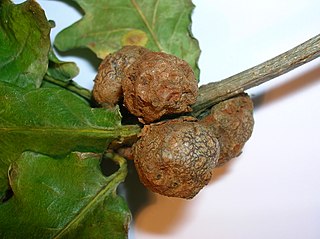
Cola-nut galls develop as a chemically induced distortion of leaf axillary or terminal buds on pedunculate oak or sessile oak trees, caused by the agamic gall wasp Andricus lignicola which lays single eggs within leaf buds using their ovipositor. A previous name or synonym for the species A. lignicola is A. lignicolus and A. venheurni.
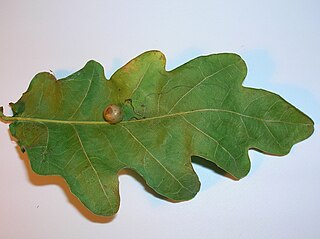
The red-pea gall or red currant gall develops as a chemically induced distortion arising from the underside of the mid-rib of a vein on Quercus species and it is attached by a short stalk or peduncle. The red-wart gall is the sexual phase of the same species.

Rabdophaga rosaria is a gall midge which forms Camellia galls or terminal rosette gall on willow species. It was first described by Hermann Loew in 1850.

Eriophyes tiliae is a mite that forms the lime nail gall or bugle gall. It develops in a chemically induced gall; an erect, oblique or curved distortion rising up from the upper surface of the leaves of the lime (linden) trees, such as the large-leaved lime tree Tilia platyphyllos, the common lime tree Tilia × europaea, etc.

The common spangle gall on the underside of leaves and the currant gall on the male catkins or occasionally the leaves, develop as chemically induced distortions on pedunculate oak, or sessile oak trees, caused by the cynipid wasp Neuroterus quercusbaccarum which has both agamic and bisexual generations.
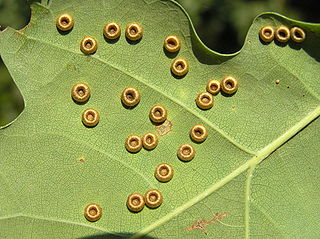
Neuroterus numismalis is a gall wasp that forms chemically induced leaf galls on oak trees. It has both bisexual and agamic (parthenogenetic) generations and forms two distinct galls on oak leaves, the silk button gall and blister gall. The galls can be very numerous with more than a thousand per leaf.
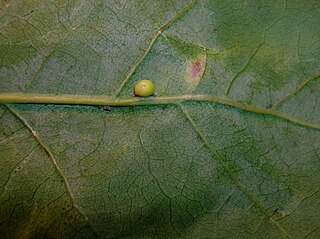
Neuroterus anthracinus is a widely distributed gall wasp that forms chemically induced leaf galls on oak trees. N. anthracinus has both sexual and agamic generations and in consequence forms two distinct galls, the oyster gall and April-bud gall.

The nettle pouch gall develops in leaf veins, leaf petioles, flower stalks and sometimes the stem of Urtica dioica and Urtica urens. This structure is caused by the gall midge or gnat Dasineura urticae, also spelled Dasyneura urticae. Synonyms are Perrisia urticae and Cecidomyia urticae.

Andricus grossulariae is a gall wasp species inducing agamic acorn cup galls on oak tree acorn cups and sexual phase galls on catkins. Synonyms include Andricus fructuum, Andricus gemellus, Andricus intermedius, Andricus mayri and Cynips panteli.

The Pineapple gall adelgid is a type of conifer-feeding insect that forms pineapple-shaped plant galls on its host species, commonly Norway and Sitka spruce. The adelgids are pear-shaped, soft-bodied green insects with long antennae, closely related to the aphid. Adelges lays up to one hundred eggs at a time, one on each needle. Adelges abietis is one of the most common species; synonyms are A. gallarum-abietis, Chermes abietis and Sacciphantes abietis.
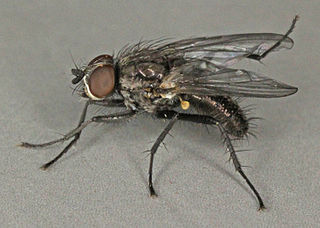
Chirosia betuleti is a species of fly, which causes knotting gall in ferns. The gall develops in the terminal shoots of ferns, such as broad buckler fern, male fern, lady fern, and ostrich fern.

Phyllocoptes eupadi is a mite that chemically induces a pouch gall to develop as a sub-spherical distortion rising up from the upper surface of the lamina of leaves of blackthorn shrubs Prunus padus, Prunus spinosa and other Prunus species. Synonyms are Phytoptus padi Nalepa, 1890 and "Eriophyes padi ", non Eriophyes padi Domes, 2000.

Biorhiza pallida is a gall wasp species in the family Cynipidae. This species is a member of the tribe Cynipini: the oak gall wasp tribe. Cynipini is the tribe partially responsible for the formation of galls known as oak apples on oak trees. These are formed after the wasp lays eggs inside the leaf buds and the plant tissues swell as the larvae of the gall wasp develop inside. This wasp has a widespread distribution within Europe.

Andricus curvator is a gall wasp which forms chemically induced leaf galls on oak trees and has both agamic and sexual generations. Agamic and sexual generations usually form two distinct galls on oak trees, but in the case of A. curvator there are six galls; the sexual generation usually on the leaf, occasionally in a twig or catkin, and the agamic generation in a bud. The wasp was first described by Theodor Hartig, a German biologist, in 1840 and is found in most of Europe.





















